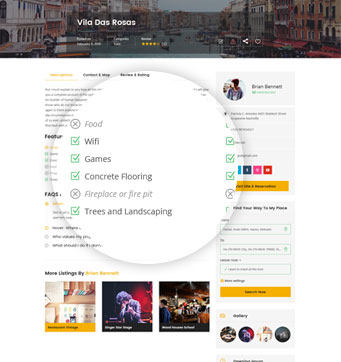A Guide to Crafting an Effective Business Listing
Enhancing local search visibility is pivotal for driving traffic, attracting customers, and boosting revenue. Leveraging business listings on prominent platforms can significantly amplify a business’s online presence and facilitate seamless customer engagement. This comprehensive guide elucidates the intricacies of creating the perfect business listing and harnessing its potential to maximize business visibility and growth.
Understanding the Significance of Business Listings:
Business listings serve as virtual storefronts, offering vital information about a business and fostering trust among potential customers. An informative and visually appealing listing with updated information, reviews, and images not only attracts local users but also converts them into loyal patrons. The accessibility and cost-effectiveness of business listings make them indispensable tools for businesses seeking to augment their online presence.
Identifying Key Listing Platforms:
Selecting the right listing platforms is crucial for optimizing business visibility. Among the plethora of options available, several prominent sites warrant consideration due to their expansive reach and influence:
Google My Business: As the leading search engine globally, Google My Business offers unparalleled visibility, making it an indispensable platform for creating business listings.
Bing Places: Despite a relatively smaller market share, Bing Places still commands significant traffic, warranting inclusion for businesses seeking broader exposure.
Yelp: Renowned for its business review system, Yelp plays a pivotal role in shaping consumer decisions, making it a valuable platform for businesses aiming to bolster their reputation and revenue.
Nextdoor: Facilitating hyperlocal marketing, Nextdoor enables businesses to target customers within their neighborhoods, enhancing community engagement and patronage.
Yahoo Localworks: Powered by Bing, Yahoo Localworks extends businesses’ reach to a diverse audience, albeit with a smaller market share, making it a worthwhile addition to listing strategies.
While these platforms represent the cornerstone of business listings, other niche sites such as Foursquare, HotFrog, eLocal, and SuperPages merit consideration based on specific business demographics and target audiences.
Strategizing Listing Management:
Given the multitude of listing sites available, strategic management is imperative to optimize resources and efficacy. Businesses can adopt two primary approaches to listing management:
Selective Listing: Prioritize platforms that align with business objectives and offer maximum visibility, such as Google and Yelp. Additionally, focus on hyperlocal sites like Nextdoor to cater to specific geographical segments effectively.
Utilize SEO Tools: Leverage SEO tools like Ubersuggest to optimize listing information for search engines and streamline distribution across multiple platforms simultaneously, ensuring comprehensive coverage and visibility.
Setting Up Your Business Profile:
Establishing a business profile entails a systematic process tailored to each platform’s requirements. Here’s a step-by-step guide for setting up a business profile on Google My Business:
Locate Your Business: Access the Google My Business platform and search for your business to claim ownership or request an ownership transfer if already claimed by another entity.
Verification: Await approval for ownership transfer requests and receive email confirmation to commence managing the listing effectively.
Completion: Provide comprehensive business information, including contact details, operating hours, and website links, to enhance accessibility and credibility.
Optimization: Optimize the listing with relevant keywords, descriptions, and images to bolster visibility and appeal to potential customers.
Optimizing Your Business Listing for Local SEO:
Maximizing the efficacy of a business listing necessitates optimization for local SEO. Key strategies for optimizing a business listing include:
Up-to-Date Contact Information: Ensure inclusion of accurate contact details, business hours, and address to facilitate seamless navigation for users.
Comprehensive Data: Supplement contact information with essential details such as website links, SEO-optimized descriptions, and social media profiles to augment engagement and relevance.
Visual Enhancement: Incorporate high-quality images showcasing products, services, and premises to captivate users and enhance brand perception.
Voice Search Optimization: Tailor listing content to accommodate voice search queries by integrating conversational keywords and informative responses.
National/Global Visibility: While emphasizing local search, maintain visibility in national and global searches by optimizing listing content for broader audience reach.
Leveraging Additional Features and Tools:
Explore additional features and tools to further enhance listing effectiveness and engagement:
Customer Review Management: Respond promptly to customer reviews, both positive and negative, to foster engagement, build trust, and address concerns effectively.
Google Smart Campaigns: Simplify advertising efforts with Google Smart Campaigns, leveraging automated ad creation and distribution to expand reach and maximize visibility.
Visual Content Enhancement: Incorporate diverse and authentic visual content to appeal to users and influence their purchasing decisions positively.
Real-Time Trend Analysis: Utilize tools like Google Trends to identify emerging search trends and align listing content accordingly for heightened relevance and visibility.
Landing Page Optimization: Optimize landing pages with relevant keywords, testimonials, and contact forms to facilitate seamless user interaction and conversion.
Conclusion:
Crafting the perfect business listing is a multifaceted endeavor that requires meticulous planning, optimization, and strategic management. By leveraging prominent listing platforms, optimizing content for local SEO, and embracing innovative tools and features, businesses can amplify their online presence, attract customers, and drive revenue growth effectively. As the digital landscape evolves, maintaining vigilance and adaptability are essential to sustain visibility and relevance in an ever-changing marketplace.






